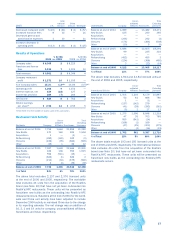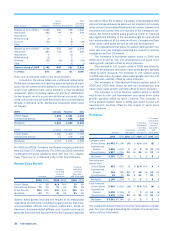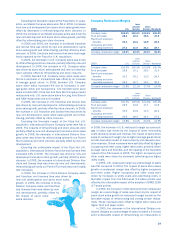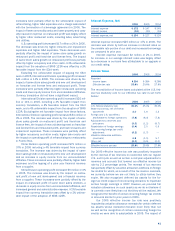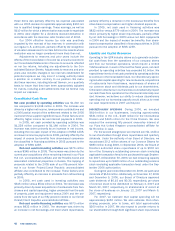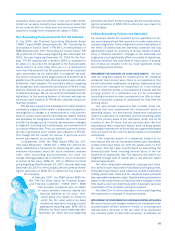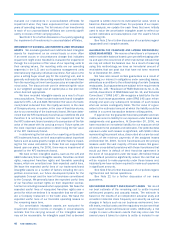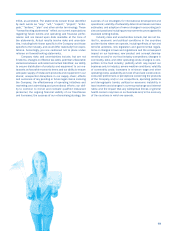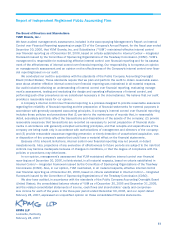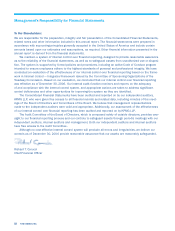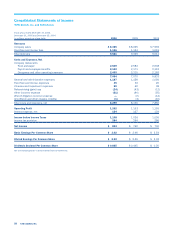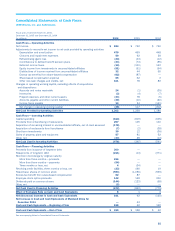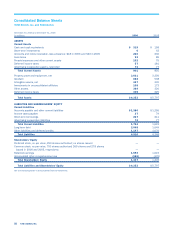Pizza Hut 2006 Annual Report Download - page 42
Download and view the complete annual report
Please find page 42 of the 2006 Pizza Hut annual report below. You can navigate through the pages in the report by either clicking on the pages listed below, or by using the keyword search tool below to find specific information within the annual report.
47
reserve, increasing our confidence level that the recorded
reserve is adequate.
See Note 22 for a further discussion of our insurance
programs.
PENSION PLANS Certain of our employees are covered under
defined benefit pension plans. The most significant of these
plans are in the U.S. In accordance with our fourth quarter
2006 adoption of the recognition provisions of SFAS 158, we
have recorded the under-funded status of $191 million for
these U.S. plans as a pension liability in our Consolidated
Balance Sheet as of December 30, 2006. These U.S. plans
had projected benefit obligations (“PBO”) of $864 million and
fair values of plan assets of $673 million.
The PBO reflects the actuarial present value of all benefits
earned to date by employees and incorporates assumptions
as to future compensation levels. Due to the relatively long
time frame over which benefits earned to date are expected
to be paid, our PBO’s are highly sensitive to changes in dis-
count rates. For our U.S. plans, we measured our PBO using a
discount rate of 5.95% at September 30, 2006. This discount
rate was determined with the assistance of our independent
actuary. The primary basis for our discount rate determination
is a model that consists of a hypothetical portfolio of ten or
more high-quality corporate debt instruments with cash flows
that mirror our expected benefit payment cash flows under
the plans. In considering possible bond portfolios, the model
allows the bond cash flows for a particular year to exceed the
expected benefit cash flows for that year. Such excesses are
assumed to be reinvested at appropriate one-year forward
rates and used to meet the benefit cash flows in a future
year. The weighted average yield of this hypothetical portfolio
was used to arrive at an appropriate discount rate. We also
insure that changes in the discount rate as compared to the
prior year are consistent with the overall change in prevailing
market rates. A 50 basis point increase in this discount rate
would have decreased our U.S. plans’ PBO by approximately
$71 million at our measurement dates. Conversely, a 50 basis
point decrease in this discount rate would have increased our
U.S. plans’ PBO by approximately $77 million at our measure-
ment dates.
The pension expense we will record in 2007 is also
impacted by the discount rate we selected at our measure-
ment dates. We expect pension expense for our U.S. plans
to decrease approximately $7 million to $59 million in 2007.
The decrease is primarily driven by a decrease in recognized
actuarial loss of $6 million in 2007. A 50 basis point change
in our weighted average discount rate assumption at our mea-
surement date would impact our 2007 U.S. pension expense
by approximately $13 million.
The assumption we make regarding our expected long-
term rates of return on plan assets also impacts our pension
expense. Our estimated long-term rate of return on U.S. plan
assets represents the weighted-average of historical returns
for each asset category, adjusted for an assessment of cur-
rent market conditions. Our expected long-term rate of return
on U.S. plan assets at September 30, 2006 was 8.0%. We
believe this rate is appropriate given the composition of our
plan assets and historical market returns thereon. A one per-
centage point increase or decrease in our expected long-term
rate of return on plan assets assumption would decrease or
increase, respectively, our 2007 U.S. pension plan expense
by approximately $6 million.
The losses our U.S. plan assets have experienced, along
with a decrease in discount rates over time, have largely con-
tributed to an unrecognized actuarial loss of $216 million in
the U.S. plans. For purposes of determining 2006 expense,
our funded status was such that we recognized $30 million
of previously unrecognized actuarial loss. We will recognize
approximately $24 million of unrecognized actuarial loss in
2007. Given no change to our current assumptions, actuarial
loss recognition will remain at an amount near that to be
recognized in 2007 over the next few years before it begins
to gradually decline.
See Note 15 for further discussion of our pension and
post-retirement plans.
STOCK OPTIONS AND STOCK APPRECIATION RIGHTS EXPENSE
Compensation expense for stock options and stock apprecia-
tion rights (“SARs”) is estimated on the grant date using a
Black-Scholes option pricing model. Our specific weighted-
average assumptions for the risk-free interest rate, expected
term, expected volatility and expected dividend yield are docu-
mented in Note 16. Additionally, under SFAS 123R we are
required to estimate pre-vesting forfeitures for purposes of
determining compensation expense to be recognized. Future
expense amounts for any particular quarterly or annual period
could be affected by changes in our assumptions or changes
in market conditions.
In connection with our adoption of SFAS 123R, we deter-
mined that it was appropriate to group our awards into two
homogeneous groups when estimating expected term and
pre-vesting forfeitures. These groups consist of grants made
primarily to restaurant-level employees under our Restaurant
General Manager Stock Option Plan (the “RGM Plan”) and
grants made to executives under our other stock option plans.
Historically, approximately 20% of total options granted have
been made under the RGM Plan.
Grants under the RGM Plan typically cliff vest after four
years and grants made to executives under our other stock
option plans typically have a graded vesting schedule and
vest 25% per year over four years. We use a single weighted-
average expected term for our awards that have a graded vest-
ing schedule as permitted by SFAS 123R. We revaluate our
expected term assumptions using historical exercise and post-
vesting employment termination behavior on a regular basis.
Based on the results of this analysis, we have determined that
six years is an appropriate expected term for awards to both
restaurant level employees and to executives.
Prior to the adoption of SFAS 123R in 2005 we have
traditionally based expected volatility on Company specific
historical stock data over the expected term of the option.
Subsequent to adoption, we revaluated expected volatility,
including consideration of both historical volatility of our stock
as well as implied volatility associated with our traded options.
Based on this analysis, our weighted average volatility used in
the determination of fair value for 2006 grants was 31%.
Prior to our adoption of SFAS 123R in 2005 we recorded
reductions in expense due to pre-vesting forfeitures as they
occurred. In connection with the adoption of SFAS 123R we
have estimated forfeitures based on historical data. Based on
such data, we believe that approximately 45% of all awards


